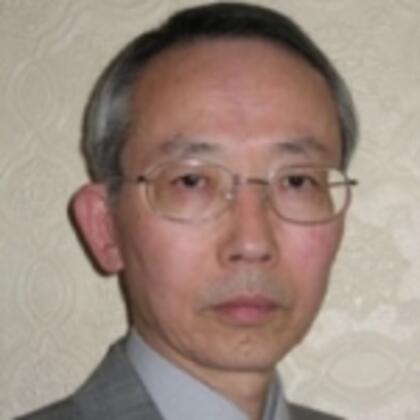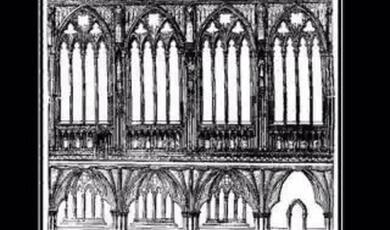Japanese Women in Tanka Poetry: from the 4th to the 13th Century
Share
- Details
- Text
- Audio
- Downloads
- Extra Reading
Hisashi Nakamura and Ria Ulleri introduced the poetic world of Tanka - an ancient form of Japanese poetry - together with slides of pieces of art which have been designed to reflect the poetry.
Download Text
From the 4th to the 13th century
Dr Hisashi Nakamura
Tanka Reading (indicated in italics): Ria Ulleri
Good evening, everybody. Thank you for coming here today.
Before I start I would like to thank the City of London Festival and Gresham College for providing the Anglo-Japanese Tanka Society with an opportunity to introduce tanka poetry. My thanks also go to Ria Ulleri who has kindly agreed to read tanka poems for me, and to the Japanese Embassy and Japan Airlines for their continuing support for tanka poetry events in Britain.
This evening I would like to introduce tanka poetry very briefly and then four women poets with their poems. They lived between the 4th century and the 13th century.
Tanka means “short poem” or “short song”. A tanka consists of 31 Japanese syllables. They are usually divided into syllabic units of 5-7-5-7-7. Here I have to confirm an important point. The tanka poems I will introduce tonight have been translated by me into English. When tanka poems are translated into English it is almost impossible to reproduce the number of syllables that occur in the Japanese. However, when original tanka are written in English it is possible to use the 5-7-5-7-7 syllable form. As examples here are two tanka I have written in English.
The far meeting point
Of the sea and the pale sky
Trembles in the haze.
The warm sleeping dunes exhale
The remains of the summer.
Stifled by the air
Laden with the rusty dust
Of the passing years
The dead cranes in the shipyard
Idly dangle their cables.
We don’t know when Japanese people started to write tanka poems. However, there are about 4,500 poems that survive from the second half of the 8th century and the great majority of these are in the tanka form. Following this, Japan produced 21 Imperial Anthologies of tanka poems. Here “Imperial Anthologies” means that they were compiled by Imperial command. Among these Imperial Anthologies the first one, with over 1,100 tanka, and the eighth, with nearly 2,000 tanka, have significance in terms of quality and history. All the tanka I will introduce this evening were written before 1205.
Tanka exerted a far-reaching influence on the aesthetics of No theatre, the tea ceremony, ceramic art and on haiku poetry, which developed in the 17th century, and on British and American Imagist poets in the early 20th century. Among these influences I would like to refer to the influence on No Theatre and the tea ceremony.
The notion of “yugen” became one of the key elements in tanka poetry. “Yugen” is a subtle and profound atmosphere. It is also an infinite tranquil space with lingering suggestiveness. “Yugen”
avoids detailed descriptions. I have chosen two tanka to illustrate “yugen”.
Even a body without a heart
Can feel this sad beauty;
Snipe take wing from the marsh
In the autumn dusk.
Here, “a body without a heart” means that in those days people thought that trained monks like Monk Saigyo had no hearts which could be moved by sentiments such as sadness, joy or anger, since they were following Buddhist disciplines in order to detach themselves from earthly thoughts and desires.
Cormorant fishing –
Maybe they are poling
Through the shallows.
Swinging and tangling
The brazier flares.
The influence of Yugen on No theatre and the atmosphere of Yugen can be seen in the following visual images.
Next the influence on the Tea Ceremony.
Cherry blossom in spring and crimson leaves in autumn typified Japanese beauty. It is still the case to some extent. And many tanka were written about cherry blossom and autumn tints. Based on this colourful sense of beauty the most powerful samurai in the mid 16th century, Hideyoshi, built a golden tea room.
However, well before this, tanka poetry had a sense of beauty which was very different from colourful spring and autumn scenes. And serious tea masters were influenced by this old sense of beauty. Here is a tanka which was highly admired by tea masters.
As far as one can see,
No cherry blossoms
Or crimson leaves-
A thatched hut by a bay
In the autumn dusk.
There are two interpretations of this tanka. One is that the speaker thinks that the scene is beautiful because there isn’t anything that is commonly considered to be beautiful such as cherry blossoms or crimson leaves. The other is that the speaker thinks that the scene is perfect without adding anything that is commonly thought to be beautiful. In any case this tanka shows the notion of “Less is More”.
So tea masters loved simplicity.
A tea room with minimal furniture and utensils.
A monochrome tea bowl without any decorations.
A bamboo vase for just one flower.
You may also find the notion of “yugen” in these things.
Now I would like to introduce the first woman poet this evening.
Empress Iwa no Hime was the wife of Emperor Nintoku and they lived in the 4th century, when the Romans were still in Britain. My focus will be on the fact that she left the Emperor in the year 342.
She must have been an important woman as her burial place shows. However, Emperor Nintoku had more power than her as his burial place shows. This is the largest burial place in the world in terms of area or the size of land.
A written record shows that Iwa no Hime and Nintoku exchanged poems in January 334. I will ask Ria to read two of them.
On my oath as a noble
I’d like to place
A spare alongside
In case my bowstring should snap.
If it were clothes
It would be fine
To put on one over another.
But your idea is terrifying
Of laying futon side by side.
As you can guess, Nintoku wanted to bring a second wife into the Palace. It is recorded that as Iwa no Hime did not allow Nintoku to bring Princess Yata into the Palace Nitoku tried to persuade his wife through exchanges of poems.
Nintoku is remembered as a good Emperor in history. A written record says that he decided not to tax people for three years after he saw villages where he could not find any smoke coming out from the kitchens. However, he was a man who was attracted to women. The following series of four tanka by Iwa no Hime shows this fact and her sufferings.
My Lord has departed
And the days have passed.
Shall I search the mountains,
Going forth to meet him,
Or wait and wait for him?
No! I would not live,
Longing for you.
Rather, high on the mountain,
A rock for my pillow,
I prefer to die.
Just as I am
I shall wait for my lord
Till on my black hair,
Trailing unconfined,
The frost shall fall.
As the morning mist trails
Over the ears of rice
In the autumn field,
I know not when or where
My love will clear away.
In September 342 a crisis occurred. Nintoku brought Princess Yata into the Palace while Iwa no Hime was away. This led to Iwa no Hime’s leaving Nintoku.
Generally speaking Iwa no Hime is remembered as a woman who had a strong sense of jealousy, but I think she should be remembered as a woman of pride.
Now I would like to move to the second poet.
Ono no Komachi was a lady-in-waiting at the Palace. She was active around the mid 9th century when Britain was under attack by the Vikings.
First of all I will ask Ria to read some of her tanka poems.
Was it because I went to sleep
Thinking always of him
That I caught a glimpse of him?
Had I known it a dream
I would not have awoken.
When I cannot meet him
On a moonless night
Passion rises within me;
A flame running through my breast
Sets my heart on fire.
Without showing a change in colour
The thing that fades
In this world
Is the flower
Called the human heart.
The colour of the cherry blossom
Has faded vainly
In the long rain
While in idle thoughts
I have spent my life.
Alas!
How sad to think
That my body will end in pale green;
After all,
A mist over the fields.
Inspired by the last poem Catherine Scriven, a student at York St John University College where I work, has produced a textile work entitled “Smoke”. The pale green in the tanka is the smoke of cremation as it trails over the fields.
Many of Komachi’s poems were included in the first Imperial Anthology and the preface to the anthology had comments on only one woman poet. It was Komachi. Before I refer to the comments on Komachi I would like to show the result of some recent research.
Computer analysis of words and their usage in the First Imperial Anthology has found that some flowering plants were indirectly compared to women and only male poets wrote poems which included these plants. These are some of those plants. As they don’t have English names I’ll name them in Japanese.
Ominaeshi.
Hagi
Susuki.
Fujibakama.
Komachi was described in the anthology as beautiful, pitiable, not strong, and like a noble lady who is suffering from a sickness. So we can say that Komachi was the first female image created by male poets as part of the gender formation in Japanese poetry.
Well over 1,100 years after her death people in Japan still talk about Komachi’s tanka and use her name as a synonym for a beautiful lady. Akita is considered to be Komachi’s birth place. It is also famous for a strong breed of dog called Akita! In Akita they have an annual Komachi Festival. Each year 7 unmarried women are selected and they visit a Shinto Shrine, where they read tanka poems written by Komachi. This is an image of Komachi!
The Japanese attachment to Komachi can also be found in the fact that one of the so called Bullet Trains is named after her. Now I will show you three Bullet Trains. Please guess which is Komachi.
One
Two (probably not!)
Three
Yes, this is Komachi!
Next I would like to introduce the third poet, Izumi Shikibu.
Izumi Shikibu had a dynamic life just 1,000 years ago. She was one of the ladies-in-waiting of Empress Akiko, notorious for her love affairs, the author of The Diary of Izumi Shikibu and was considered to be the finest poet of the time.
Although she lived around 1,000 years ago the record of her intense love life and her marriages and love affairs has survived. She had her first child after her first marriage. Then she had an affair with Prince Tametaka, but in June 1002 Prince Tametaka died at the age of 26. In April the following year an affair started with Prince Atsumichi. Prince Atsumichi died in 1007 at the age of 27. After this she wrote The Diary of Izumi Shikibu. And then her second marriage and loss of her first child took place.
The Diary of Izumi Shikibu based on her affair with Prince Atsumichi, depicts the inner solitude and aching void of a female heart.
Now I’d like to ask Ria to read some of Izumi Shikibu’s tanka poems.
Without a thought
For my black hair’s disarray
I throw myself down,
Already longing for the one
Who ran his fingers through it.
Since even my pillow does not know,
I shall not speak.
Tell no one
What you truly saw-
A spring night’s dream.
On the bamboo leaves
A fine ice fall
Patters and patters.
How bitter
To try to sleep alone!
From one dark path
Into another
Again I may stray.
Light the long way,
Moon on the mountain rim.
In the evening,
Just glimpsing the lonely clouds,
The feeling rises in me
Never to gaze
For too long.
Tormented by my thoughts
My soul struggles
And escapes:
A firefly
Over the marsh.
Although I’ve heard
The dead return tonight,
You are not here.
Is the place where I live
A homeland without a soul?
In my loneliness,
Not to let even the smoke die down
I break twigs
And feed the flames
In this winter mountain home.
I would like to show images Laura Morgan produced after studying Izumi Shikibu’s tanka when she was an art student at York St John University College last year. I think that Laura Morgan’s images symbolise Izumi Shikibu’s life. This is a huge pillow on which she created images. These are sections of the images on the pillow.
I think that Izumi Shikibu coped with her life full of ups and downs and criticism over her affairs because she was a highly professional career woman, respected by both men and women as the finest poet of the time and was taken into Empress Akiko’s confidence.
I think we can say that for Izumi Shikibu the three things, love, life and tanka were all one, inseparable from one another.
The last poet I would like to introduce this evening is Princess Shikishi whose life was quite different from that of Izumi Shikibu.
Princess Shikishi was a daughter of Emperor Goshirakawa. She was sent to Kamo Shrine in Kyoto to serve as a virgin, consecrated for 10 years till she was 21 years old. She remained unmarried all though her life and became a nun in 1190. She died at the age of 53.
I would like to show you some scenes of the annual festival at Kamo Shrine in Kyoto during which the festival figure of a virgin sent to Kamo Shrine is carried through the city. Her isolated life at Kamo Shirne for ten years and the fact that she remained unmarried influenced the themes of her tanka.
In order to understand her tanka it is also necessary for us to pay attention to the political and social background of her time. She lived in the historical period between the end of the rule of the aristocracy and the rise of the samurai government. In those days a love affair or marriage could have become a source of political and military conflict. Love was often suppressed and “Concealed Love” became a poetic theme. It was also a period which witnessed civil wars, earthquakes, huge fires, devastating storms and starvation. She must have sensed strongly the transient nature of human existence in her daily life.
Before I ask Ria to read her tanka I would like to explain four phrases which will appear in them.
Beating Clothes:
Clothes were made soft or shiny by beating them on a wooden or stone block.
Boxwood Pillow:
Boxwood was often used to make a support on which a small pillow was placed.
Cord of my soul:
It was believed that a cord tied the soul to the body. Therefore, “cord of my soul” in effect means life itself since the separation of the soul and body means death.
The long night’s sleep:
In Buddhist teaching the “long night’s sleep” is the same as the “long night’s darkness” which is a spiritual darkness caused by earthly desires.
Deep in the mountains
The pine branch door
Does not feel the coming of spring;
Only the slow dropping of gems
From the melting snow.
From somewhere in the clouds,
A voice-
The cuckoo is sobbing.
Are his tears still falling?
A passing shower in the early evening.
The night has worn away.
The clear moon shines cold
Near the mountain edge.
And faintly from the far village of Toochi,
Someone beating clothes.
As the wind blows cold
Leafy shadows clear up
Night by night.
There is no corner left unlit;
The moonlight in the garden.
When this day
Spent gazing at your blossoms
Is long past,
You, at least, do not forget me,
Plum tree by the eaves.
Of this love of mine
There’s not one who knows.
Do not let my pent up tears overflow
As I lie here,
My dear boxwood pillow.
Guide me over
As I row my boat,
Not knowing where I am bound,
For there is no wake to follow,
Breeze on the boundless ocean.
Forgetting that the days are passing
With my heart concealed,
Unaware, I sigh
As the night falls.
Cord of my soul!
If you must break, break now.
For if I live on
My power to keep this hidden
May not endure.
I know I cannot live
Until tomorrow
Grieving that you are cold-hearted.
If you come, let it be
Before this night falls.
The crowing of the rooster at dawn
Pierces me to the heart,
Here on my pillow,
Heavy with thoughts
Of the long night’s sleep.
Looking afar
In the stillness of each dawn
I am filled with sadness
That the world has not awoken
From the long night’s sleep.
I think I should let Princess Shikishi’s tanka speak for themselves and not disturb them by my comments.
We have seen four Japanese female poets. They speak to us directly and vividly across the centuries. Although they lived in such a different society and culture from that of Britain today I cannot help thinking that the inner lives of these women poets who lived about a thousand years ago were not very different from those of women today. These tanka remind us that human emotions are truly universal.
As a way of ending my talk I will ask Ria to read one more tanka by Princess Shikishi and a quotation from Shakespeare.
Broken by the sound of the breeze
That plays on the bamboo leaves
Near the window,
A dream even shorter
Than my fleeting sleep.
We are such stuff as dreams are made on,
And our little life is rounded with a sleep.
(The Tempest, 1611)
Thank you very much indeed!
© Dr Hisashi Nakamura and Ria Ulleri, Gresham College, 6 July 2006
This event was on Thu, 06 Jul 2006
Support Gresham
Gresham College has offered an outstanding education to the public free of charge for over 400 years. Today, Gresham College plays an important role in fostering a love of learning and a greater understanding of ourselves and the world around us. Your donation will help to widen our reach and to broaden our audience, allowing more people to benefit from a high-quality education from some of the brightest minds.


 Login
Login









